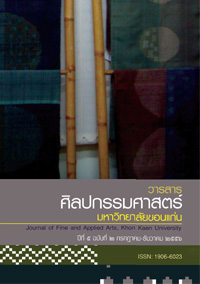กระบวนการถ่ายทอดขิม “รู้จักฟังเสียง 5 ประการ” ของมูลนิธิหลวงประดิษฐไพเราะ (ศร ศิลปบรรเลง)
Main Article Content
Abstract
การจะเป็นนักดนตรีไทยที่ดีจะต้องได้รับการฝึกฝนอย่างมาก มูลนิธิหลวง ประดิษฐไพเราะ (ศร ศิลปบรรเลง)ได้รวบรวมหลักปฏิบัติที่เป็นคุณสมบัติที่ดีของ นักดนตรีเรียกว่า“ทฤษฎีภายในดนตรีไทย” มี 4 ขั้นตอน รวม 18 ข้อ ในส่วนที่ผู้วิจัย ทำการศึกษา คือ ขั้นตอนที่ 2 รู้จักฟังเสียง 5 ประการ เป็นเสียงที่ นักดนตรีจะต้องรับรู้และเข้าใจ ได้แก่ 1) เสียงที่นักดนตรีได้ยินอยู่ในใจ 2) เสียงที่นักดนตรีบรรเลง 3) เสียงที่ผู้อื่นบรรเลง 4) เสียงที่เกี่ยวข้องกับการบรรเลงและ 5) เสียงที่ไม่เกี่ยวข้อง กับการบรรเลง โดยแบ่งประเด็นศึกษาดังนี้ 1) จุดเด่นของทฤษฎีรู้จักฟังเสียง 5 ประการ 2) การเตรียมผู้เรียน 3) กระบวนการถ่ายทอดขิม 4) วิธีวัดผลประเมินผล 5) ปัญหา อุปสรรคและวิธีการแก้ไขปัญหา
ทั้ง 5 เสียงสัมพันธ์ (4 สัมพันธ์ 1 เพิกถอน) เป็นหลักปฏิบัติที่สามารถใช้ ในการฝึกโสตทักษะ ทำให้นักดนตรีมีสติ มีสมาธิในการบรรเลงดนตรีโดยจุดเด่นของ ทฤษฎี รู้จักฟังเสียง 5 ประการ เป็นกระบวนการฝึก ที่สำคัญทำให้นักดนตรีมีทักษะ ในการฟังและจำแนกเสียงต่างๆที่เกี่ยวข้องกับการบรรเลงและไม่เกี่ยวข้องกับการ บรรเลง สามารถบรรเลงดนตรีได้ไพเราะและถูกต้อง
ในการเตรียมผู้เรียน จะเตรียมในลักษณะของการสื่อสารของครูกับผู้เรียน ฝึกให้ผู้เรียนฟัง ให้ผู้เรียนทราบเหตุผลและความจำเป็นของการฝึก รู้จักฟังเสียง 5 ประการ แล้วจึงปฏิบัติในส่วนที่ง่ายก่อน จนสามารถทำได้ครบทุกขั้นตอน ส่วน กระบวนการถ่ายทอดนั้น ครูผู้สอนจะใช้กระบวนการสอนทั้งแบบครู เป็นศูนย์กลาง และผู้เรียนเป็นศูนย์กลางเพื่อให้ผู้เรียนบรรลุวัตถุประสงค์ในการเรียน และสำหรับ การวัดผลประเมินผล ได้กำหนดแนวปฏิบัติของทฤษฎี รู้จักฟังเสียง 5 ประการ เป็นกรอบในการประเมินโดยใช้วิธีการสังเกตผลจากการปฏิบัติของผู้เรียน
TRANSMISSION OF TEACHING KHIM (THAI ZITHER) “RU CHAK FANG SEANG HA PRAKARN” BY LUANG PRADITPAIROH (SORN SILPABANLENG) FOUNDATION
The result showed that being a good Thai musician should be well trained. Luang Pradit Pairoh foundation had gathered good fundamental of musician called “Internal Theory of Thai classical music”. There were 4 steps, in total of 18 rules. And this research chose to study on step two which was Ru Chak Fang Seang Ha Prakarn, meaning learning how to listen the 5 types of musical sound. The 5 types of musical sound included 1) sound which musician can hear in their mind 2) sound which musician perform 3) sound which other musician perform 4) sound related to music 5) sound not related to music.
The research chose to focus on 1) The prominence of this theory 2) Preparations for learners 3) The teaching procedure 4) evaluation 5) Problem and Solution.
These 5 related sounds (4 related and 1 unrelated) were the rules of practice in order to gain hearing skills. The practice gave concentration and consciousness to musicians. The prominent of this theory was a vital practice procedure for musicians to gain more hearing skills and to be able to identify the sounds which related to music and unrelated to music. Moreover, when completing the whole practice musicians could play more musically.
Preparations for learners were made in term of communication between teacher and student. First, training students to learn how to listen and know the reasons of the practices were necessarily. Then, easy practices were done gradually step by step until complete the whole steps. The teaching procedure focused on both teacher-centered learning and student-centered learning in order to achieve its objective. In th part of evaluation, observation on students and practice were employed.Article Details
Content and information in articles published in the Journal of Fine and Applied Arts of Khon Kaen University is regarded as the opinion and sole responsibility of the author(s) directly; therefore, editors are not obliged to agree to or share any responsibility with regard to the content and information that appears within these articles.
All articles, information, content, image, etc. that have been published in the Journal of Fine and Applied Arts of Khon Kaen University is the copyright of the Journal of Fine and Appllied Arts of Khon Kaen University. Any person or organization who wishes to distribute all or parts of the articles for further dissemination or other usage must first receive permission from the Journal of Fine and Applied Arts of Khon Kaen University before proceeding to do so.


